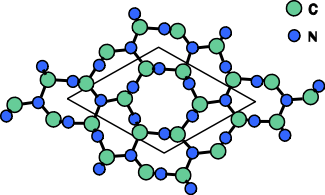Beta carbon nitride

Beta carbon nitride (β-C3N4) is a superhard material predicted to be harder than diamond.[1]
The material was first proposed in 1985 by Marvin Cohen and Amy Liu. Examining the nature of crystalline bonds they theorised that carbon and nitrogen atoms could form a particularly short and strong bond in a stable crystal lattice in a ratio of 1:1.3. That this material would be harder than diamond on the Mohs scale was first proposed in 1989.[2]
The material has been considered difficult to produce and could not be synthesized for many years. Recently, the production of beta carbon nitride was achieved. For example, nanosized beta carbon nitride crystals and nanorods of this material were prepared by means of an approach involving mechanochemical processing.[3][4][5][6]
Production
Processing
Through a mechanochemical reaction process, β-C3N4 can be synthesized. This method is achieved by ball milling high purity graphite powders down to an amorphous nanoscale size while under an argon atmosphere, then the argon is purged and the graphite powders are introduced to an NH3 gas atmosphere, which after high energy ball milling, has been found to form a nanosized flake-like structure of β-C3N4.[5] During milling, fracture and welding of the reactants and graphite powder particles occur repeatedly from ball/powder collisions. Plastic deformation of the graphite powder particles occur due to the shear bands decomposing into sub-grains that are separated by low-angle grain boundaries, further milling decreases the sub-grain size until nanosize sub-grains form. The high pressure and intense motion promotes catalytic dissociation of NH3 molecules into monatomic nitrogen on the fractured surface of the carbon. Nanosized carbon powders act substantially different from its bulk material as a result of particle dimension and surface area, causing the nanosized carbon to easily react with the free nitrogen atoms, forming β-C3N4 powder.[6]
Producing nanorods
Single crystal β-C3N4 nanorods can be formed after the powder-like or flake-like compound is thermally annealed with an NH3 gas flow. The size of the nanorods is determined by the temperature and time of thermal annealing. These nanorods grow faster in their axis direction that the diameter direction and have hemispherical-like ends. A cross section of the nanorods indicates that their section morphology is prismatic. It was discovered that they contain amorphous phases, however when annealed to 450 degrees Celsius for three hours under an NH3 atmosphere, the amount of the amorphous phase diminished to almost none. These nanorods are dense and twinned rather than nanotubes. Synthesizing these nanorods through thermal annealing provides an effective, low cost, and high yield method for the synthesis of single crystal nanorods.[6]
Alternate methods of synthesis
Rather than forming a powder or nanorod, the carbon nitride compound can alternatively be formed in thin amorphous films by either shock-wave compression technology, pyrolysis of high nitrogen content precursors, diode sputtering, solvothermal preparation, pulsed laser ablation, or ion implantation.[6]
Difficulties of processing
Although extensive studies on the process and synthesis of the formed carbon nitride have been reported, the nitrogen concentration of the compound tends to be below the ideal composition for C3N4. This is due to the low thermodynamic stability with respect to the elements C and N2, indicated by a positive value of the enthalpies of formation. The commercial exploitation of nanopowders is very limited by the high synthesis cost along with difficult methods of production that causes a low yield.[5][6]
Characteristics
Structure
The structure was determined by Fourier transformation infrared spectroscopy, transmission electron microscopy, and X-ray diffraction. By using an SAED, a polycrystalline β-C3N4 with a lattice constant of a = 6.36 Å, c = 4.648 Å can be determined. Thermal annealing can be used to change the flake-like structure into sphere- or rod-like structures.[5]
It has the same crystal structure as β-Si3N4 with a hexagonal network of tetrahedrally (sp3) bonded carbon and trigonal planar nitrogen (sp2).[6]
The nanorods are generally straight and contain no other defects.[6]
Properties
Properties show a hardness equal or above diamond, the hardest known material.[2]
The bulk modulus of diamond is 4.43 MBar while β-C3N4 only has a bulk modulus of 4.27 MBar(± .15). This is the closest conceived bulk modulus to diamond.[2]
Possible applications
Promising in the field of tribology, wear resistant coating, optical engineering, and electronic engineering.[6]
Composite opportunities also exist using TiN as seeding layers for carbon nitride, which produces actual crystalline composites with hardness at levels of 45-55 (GPa) which is on the lower end of diamond.[2]
The predicted hardness for pure beta carbon nitride(4.27 ± .15 Mbar) is similar to that of diamond (4.43 Mbar), giving it the potential to be useful in the same fields as diamond.[2]
See also
References
- ↑ Ball, P. (5 Jun 2000). "News: Crunchy filling". Nature. doi:10.1038/news000511-1.
- 1 2 3 4 5 Liu, A. Y.; Cohen, M. L. (1989). "Prediction of New Low Compressibility Solids". Science. 245 (4920): 841–842. doi:10.1126/science.245.4920.841. PMID 17773359.
- ↑ Niu, C.; Lu, Y. Z.; Lieber, C. M. (1993). "Experimental Realization of the Covalent Solid Carbon Nitride". Science. 261 (5119): 334–337. doi:10.1126/science.261.5119.334.
- ↑ Martín-Gil, J.; Martín-Gil, F. J.; Sarikaya, M.; Qian, M.; José-Yacamán, M.; Rubio, A. (1997). "Evidence of a Low-Compressibility Carbon Nitride with Defect-Zincblende Structure". Journal of Applied Physics. 81 (6): 2555–2559. doi:10.1063/1.364301.
- 1 2 3 4 Yin, L. W.; Li, M. S.; Liu, Y. X.; Sui, J. L.; Wang, J. M. (2003). "Synthesis of Beta Carbon Nitride Nanosized Crystal through Mechanochemical Reaction". Journal of Physics: Condensed Matter. 15 (2): 309–314. doi:10.1088/0953-8984/15/2/330.
- 1 2 3 4 5 6 7 8 Yin, L. W.; Bando, Y.; Li, M. S.; Liu, Y. X.; Qi, Y. X. (2003). "Unique Single-Crystalline Beta Carbon Nitride Nanorods". Advanced Materials. 15 (21): 1840–1844. doi:10.1002/adma.200305307.